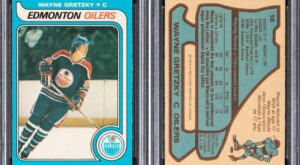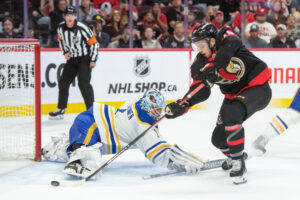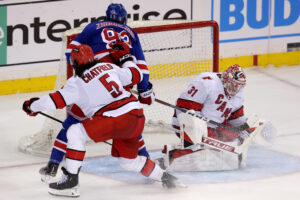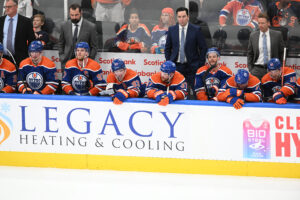One thing everyone knows is that the Vancouver Canucks learning curve has been over the course of two years. Henrik Sedin and Daniel Sedin moved on, and with them went the captaincy and a pretty good second line. Too bad it was pressed into service as a first-line, but you do what you can.
The Recent Learning Curve Among the 2019-20 Vancouver Canucks
Roller Coasters Are (Sometimes) Fun!
This year, the 2019-20 Vancouver Canucks have had a very good start; but they did last season, too, going 8-6 in October. As has been pointed out before, half of those wins came by a single goal and the losses were usually by three or more. Not really a formula indicating long-term success, that.
But more to the point, there was always a feeling of “getting lucky” in the wins. Barely escaping by the skin of their teeth. Thanking Jacob Markstrom for keeping them in long enough to get the win – or apologizing for not doing enough.
This is the sort of thing a young team is prone to do. Their winning streaks can be buoyed by adrenaline, losing streaks deepened by frustration. And despite the oldest member (Loui Eriksson) playing 81 games last season, they were a young team. No one else over the age of 25 even made it to 66 games. Injuries took out the Canucks’ more skilled players, certainly, but they also kept veterans out of the room.
Injuries will obviously decimate a thin team, but can also wreak havoc on a young one. The Canucks’ learning curve has been a steep one so far. General manager Jim Benning brought in veteran players from winning teams to address exactly that.
A Stable Full of Stability
Despite a similar record (8-3-1 for October) the feeling this season is very different. The increased depth of skill has helped tremendously, but the players brought in have also been leaders. The one “younger” player they have to trade for, J.T. Miller, is still 26-years-old and an NHL veteran. No matter what you think of who the most important players are, this can’t really be called a young team anymore.
The caveat is that the team hasn’t had any crippling injuries yet. But the feeling is that they can get through them now without collapsing. In an ideal world that won’t be tested, but come on: this IS the Vancouver Canucks we’re talking about. Injuries will test this team – it’s just a matter of when.
A more interesting trend to watch is how the team has dealt with their losses.
Successful Failures
In a virtual mirror image of 2018-19, five of Vancouver’s six losses have been by a single goal. Five of the wins were by three or more goals, and even in one of the losses they scored five times. That loss, and one other, are worth looking at more closely.
The 6-5 overtime loss to the Washington Capitals was the result of a single bad period by Markstrom. While they are a very good team, they didn’t have a particularly good game. It was the end of a long road trip, and it showed with them going down 5-1 late in the second period. A last-second goal let them go into the dressing room with some optimism, and they managed the comeback.
Likewise, the Canucks didn’t have a particularly bad game or even period. It was a reminder, if one is needed, that even your best players can have a bad game. It’s just more visible if that player is your goalie.
Three games prior, the New Jersey Devils shut the Canucks out 1-0. In the game, Vancouver’s top line of Brock Boeser – Elias Pettersson – J.T. Miller absolutely dominated. Boeser and Miller each had a Corsi of 88.1%, and Pettersson’s was 92.1%. Overall, the Canucks controlled play and should have won, but they couldn’t get one past MacKenzie Blackwood.
Deal With It
You may have noticed the language I’ve used so far: not that Washington was overpowering, but that the Canucks slipped. The Devils could do nothing about Vancouver’s best line, and they were lucky not to lose.
That is a huge difference in the conversation around the team. And it’s all part of the Canucks’ learning curve.
The game after being shut out by New Jersey, Bo Horvat was absolutely everywhere in the first period, including getting the Canucks on the scoreboard. He was determined not to let the goal drought continue and took it upon himself to do something about it.
Following the loss to the Capitals, the 2019-20 Vancouver Canucks roared out to a 4-1 lead against the Florida Panthers before the game was 10 minutes old. They picked up three more goals before the game was over, but their priority was keeping the Panthers from getting a whiff of opportunity. No way were they losing a big lead twice.
Real or Not? Does it Matter?
Seeing the 2019-20 Vancouver Canucks be frustrated at one-goal losses is heartening for their fans. In two of their three extra-time losses, they staged late comebacks to grab at least one point. There isn’t a sense of “It’s okay, we’re making progress” anymore. The Canucks believe that they deserve those wins, and are angry when they don’t get them.
That’s not saying it hasn’t been an offensive roller coaster this year. Out of 15 games, they’ve scored five or more goals in seven and fewer than two goals in four. That in itself is somewhat ridiculous, and it will settle down as the season progresses. The coming challenge is what will happen when team scoring does drop to a more sustainable level? It could be because of a return to averages for the high-percentage shooters, or injuries to top players, or just a streak of bad luck or hot goaltenders.
It’ll happen, sooner or later. But with these veterans, in this configuration – and with this depth – it might not be fatal to their playoff hopes. They say every veteran is wily, and maybe at the end of a difficult November schedule we’ll be saying the same about Jim Benning for loading up on them.
Main Photo:






